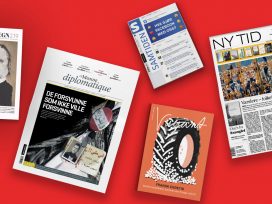17 articles

Cultural journals – a somewhat awkward placeholder term for periodicals between the arts, the sciences and politics – have played a crucial role in the formation of the public spheres in Europe and beyond. From the scholarly journals of the Republic of Letters and the periodicals and pamphlets of the Enlightenment, to the revues of the ‘Age of the Press’, the theory journals of the long 1960s, and the zines of Underground and Punk, journal-making has been an important ‘cultural technology’ that has deeply influenced the way we argue, narrate, write and think.
While there is uncertainty about the future of the book in the digital age, journals have anticipated the ongoing transformation of public spheres and retained a strong presence in intellectual and cultural life. Nevertheless, their future form and sustainability is by no means clear, and it remains to be seen how the internet will change the relationship between periodicals, their readerships and broader public spheres. In order to understand where they are headed, it helps to look at where journals have come from and how their histories can be written.
Despite the historical importance of cultural journals, only recently have they become a clearly defined area of research. Today, intellectual historians, literary scholars and sociologists are asking what it means to write for a journal (as opposed to writing a book, for example), how groups form around journals, how journals shape and are shaped by intellectual history, and what conditions cause them to thrive or struggle. In focusing on their production as well as their reception, we gain insight into the social (mostly collaborative) and economic (often precarious) dimensions of journal-making. It becomes clear that no journal can be understood in isolation. Only by looking at a journal’s relationship to other journals can we learn about its influences and distinctions from other journals.
The Eurozine focal point ‘Worlds of cultural journals’ seek to explore relationships within a transnational ‘ecosystem’ of cultural journals. Common to all the contributions is their treatment of journals – political, cultural, artistic, literary or scientific – as media actors in their own right. What may have been evident to their editors all along is still worth emphasizing: that journals do much more than ‘carry texts’ or ‘mirror social change’. They shape the texts and images they contain; they influence intellectual communities and movements; and they serve as a specific form of archives of social and cultural transformation.
Contributions come from historians and literary scholars affiliated with the Working Group on Periodicals Research and from Eurozine partner journals. They cover the history of cultural journals in specific countries and regions (Poland, the Arab Middle East), specific genres (feminist journals, journals of the New Right, architecture mags), and specific challenges (What makes a good editor? The history and problems of transnational journal networks in Europe). We hope that the focal point will strengthen the conversation between journal editors and journal historians, as well as be of interest to what any successful cultural journal depends on: its readership!
Patrick Eiden-Offe, Anke Jaspers, Moritz Neuffer, Morten Paul and Roman Schmidt for the Working Group on Periodical Research



Olivier Corpet, the journals editor and director of the Institute for Contemporary Publishing Archives, passed away on 6 October. In the 1980s he was a central figure in the founding of the European Meeting of Cultural Journals, the informal network that developed into Eurozine. Carl Henrik Fredriksson and Klaus Nellen, Eurozine co-founders, pay tribute to Corpet.

Ever since the 2008 crisis, cultural journals have been facing increasing financial, political and market pressures. Ann Ighe reviews the issues affecting Eurozine partner journal editors who met funding representatives on what became the eve of European COVID-19 lockdowns.

Norway’s cultural journals are driven by the voluntary work of idealistic writers and editors and survive on generous gifts and subsidies. This same idealism, however, allows them to document key trends and act as a ‘zeitgeist archive’.

A recent study shows that cultural journals in Estonia provide a space for criticism not offered by larger media. The Estonian cultural journal sector is among the best-funded in Europe. Despite a conservative definition of the medium – only print journals qualify for support – journals retain full independence and the field is diverse.

Rejection of rigid Marxist orthodoxies and a strong focus on the cultural forces shaping politics and society were central to New Left thought after 1956. The British journal Soundings, co-founded by the influential New Left thinker Stuart Hall, emerged from this tradition.

The use of magazines by the German far-right to integrate its ideology into acceptable political discourse goes back to the transformation of former National Socialist networks into the so-called New Right. Emphasis on the democratic function of the public sphere has caused far-right magazine publishing to be overlooked.

What started thirty-five years ago as an informal meeting of European editors became the basis for Eurozine, founded in 1998 as an online cultural journal and editorial network. One of Eurozine’s original goals – to offer print journals a gateway to digital publishing – has long been realized. Another goal, however, remains a work in progress: to act as a plural forum for transnational European debate. Two of Eurozine’s founding editors reflect on the evolution of the project.
Cultural journals have played a crucial role in the formation of the public spheres in Europe and beyond. Yet their future form and sustainability is by no means clear. Looking at journals’ history helps understand where they are headed. Introducing a new Eurozine focal point in collaboration with the Working Group on Periodicals Research.
Struggle in the street was combined with otherworldly utopias in the low budget, small circulation architectural magazines of the 1960s and 1970s. Free of the constraints of finance and convention, the genre served as an international platform for experimental design and discourse and was instrumental in the progress of architectural modernity.
Ord&Bild, Sweden’s oldest cultural journal, first appeared in 1892. Speaking at the 125th anniversary event in Gothenburg on 4 November 2017, long-time contributor Sven-Eric Liedman recalls Ord&Bild’s programme and personnel between the counter-cultural revolution of the 60s and the neoliberal revolution of the 1980s.
The Lebanese journal ‘Mawaqif’, published in various incarnations between 1968 and 1994, was one of the leading cultural journals of the Arab World. Its seventy-four issues reflect the intellectual upheavals brought by the Six-Day War, the Lebanese Civil War, and the Iranian Revolution, as well as far-reaching processes of modernization in Arab literary culture.
After 1989, cultural journals were central to the flourishing of intellectual life in Poland, enjoying circulations never reached before or since. However, neoliberalism has undermined journals’ popularity and financial viability. Dependency on public subsidies makes them increasingly vulnerable, writes the editor of ‘Czas Kultury’.
Magazines played an important role in German feminist discussion of the 1970s and ’80s. Among them, ‘Die Schwarze Botin’ stood out for its formal radicalism and intellectual originality. Critical of apolitical and affirmative tendencies in the women’s movement, it saw itself as a site both of theoretical reflection and of aesthetic experimentation. Katharina Lux on a forgotten document of New Left feminism.
There can be no doubting the historical influence of literary-intellectual magazines, but we still know little about how they were led and managed. Looking at some of the outstanding magazine editors of twentieth-century Europe, Matthew Philpotts argues that the key to success lies not just in individual talent and charisma, but also in strong editorial collectivity and social conditions favourable to publishing.



